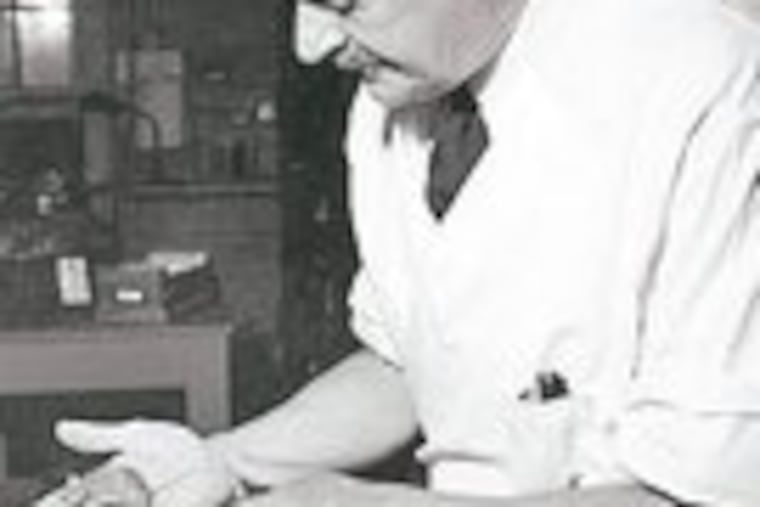Jackson Lab: Building better mice since 1933
BAR HARBOR, Maine - Ralph Waldo Emerson is reputed to have said that if a man makes a better mousetrap, "though he build his house in the woods, the world will make a beaten path to his door."

BAR HARBOR, Maine - Ralph Waldo Emerson is reputed to have said that if a man makes a better mousetrap, "though he build his house in the woods, the world will make a beaten path to his door."
Gary A. Churchill hopes this is also true if a man builds a better mouse.
Actually, it's already true.
Biologists have been beating a path to this town on Mount Desert Island since 1933, when the Jackson Laboratory began selling inbred mice for genetic research.
Today, the laboratory offers about 3,000 strains. Individual animals in each strain are essentially all the same at the genetic level - an endless stream of identical twins, except for the genes determining sex. Many have traits that mimic human ailments - diabetes, hypertension, osteoporosis and Alzheimer's disease. Others have the tendency to develop problems such as obesity, cancer or infection when subjected to the "right" environmental conditions.
In most cases, these traits (and hundreds more) arose through chance mutations in single animals. They caught the eye of a scientist, who in turn "captured" the trait by mating the animal with its siblings, and then those offspring with one another. After 25 generations, such animals are all identical and - if things go as planned - all carry the gene or genes responsible for the trait of interest.
In recent decades, genetic technology has also allowed scientists to knock out or, in some cases, add genes to animals. Of the lab's 3,000 strains, about one-third are genetically engineered.
The usefulness of these animals is hard to overstate.
They help biologists understand basic physiology. They help identify genetic defects that lead to disease. The benefits or risks of experimental drugs are often easier to detect when tried on animals that are the same.
Mice became workhorses of medical research in the decades after World War I. They were cheap and easy to raise, prolific, reached maturity quickly and were altogether more practical than larger animals such as dogs.
At the time, the mouse's genetic malleability was well known and the source of popular entertainment.
Clubs of "mouse fanciers" in the early years of the 20th century bred animals to have exotic coat colors and strange behaviors. (A type of "waltzing mice" from that period turned out to have an inner-ear defect.) This briefly fueled even a fashion fad. Full-length mouse coats, made of 400 skins, sold for about $350 in the 1930s.
A main source of early mice for research was a farm in the western Massachusetts town of Granby run by a retired schoolteacher named Abbie E.C. Lathrop. She began breeding in 1903.
A pair of mice from the Granby farm produced a lineage that became known as "Black 6" or B6. It is the most popular research mammal in the world. It was a B6 mouse whose genome was sequenced in 2002 as part of the ongoing effort to get full DNA transcripts of many life forms, from yeast and mustard plants to microscopic worms, cats and human beings.
Through much of the 20th century, scientists collected mice from around the world (including places as remote as the Faroe Islands in the North Atlantic) for breeding stock. The idea was to ensure genetic diversity in the mix of animals used to create inbred strains.
How successful this effort was - or was not - became clear only this summer.
A paper published in July in the journal Nature Genetics analyzed the DNA sequences of 15 strains of mice. Eleven were "classical" inbred strains used in laboratories for years. Four were strains derived from animals caught in the wild more recently, including one from the sewers of Prague.
To the researchers' surprise, the older strains had much less genetic diversity than anyone assumed.
About 92 percent of all those strains' genomes derive from the Mus musculus domesticus subspecies native to Western Europe. There was relatively little contribution from subspecies of Central Asia or Southeast Asia, or from a hybrid of the two found in Japan.
This told mouse geneticists there were many more variations of DNA in the mouse universe that could potentially go into making new strains of the animals.
"Only one-quarter of the total diversity in the 15 strains is present in the classical laboratory strains," says Churchill, a biostatistician at the Jackson Lab.
The Jackson Laboratory and the federal government's Oak Ridge National Laboratory, in Tennessee, are creating about 1,000 new strains of inbred mice.
The scientists are starting with a more diverse group of "founders" than went into current lab strains. They are creating the inbred lines through the classic technique of brother-sister mating.
The work will take about seven years. The result may not be better mice, but it will be more varied ones.